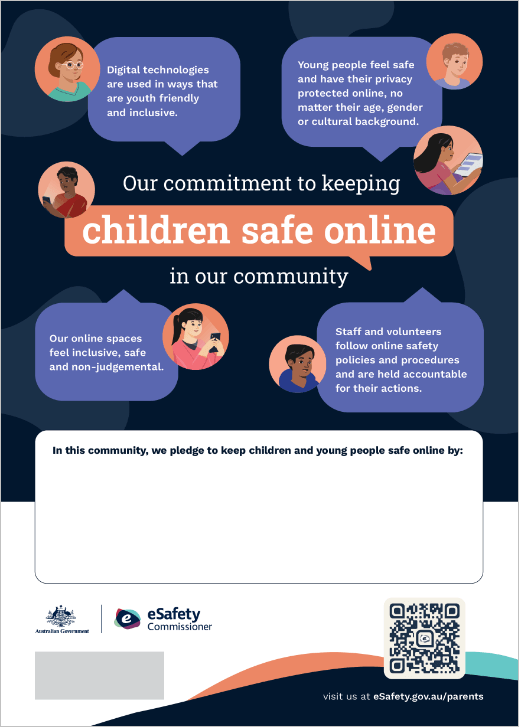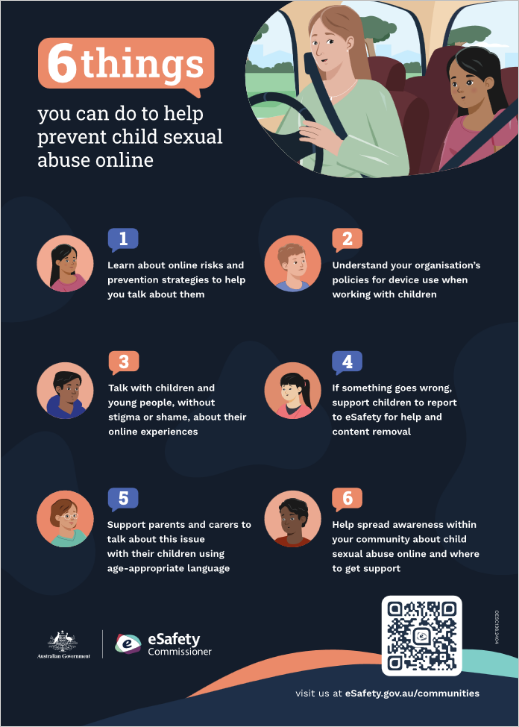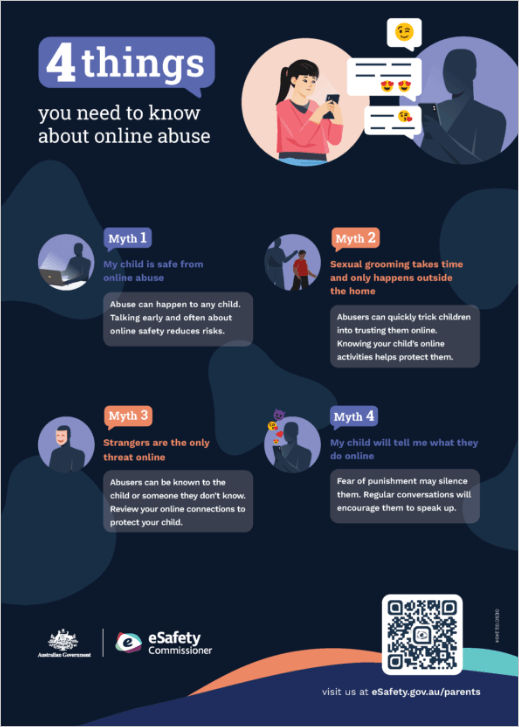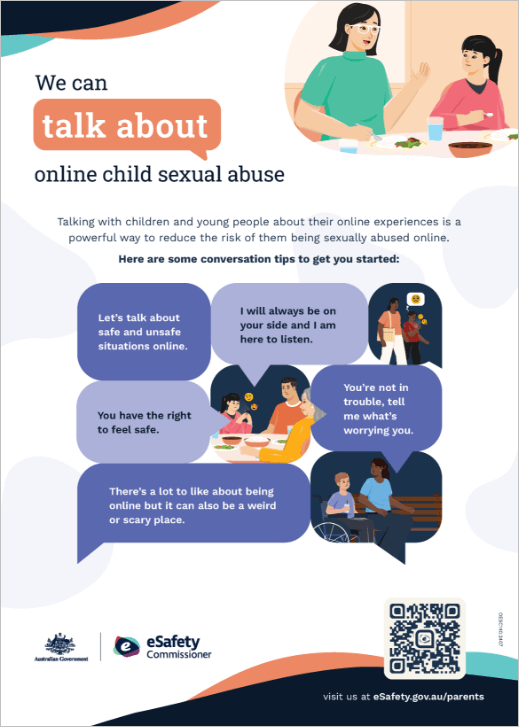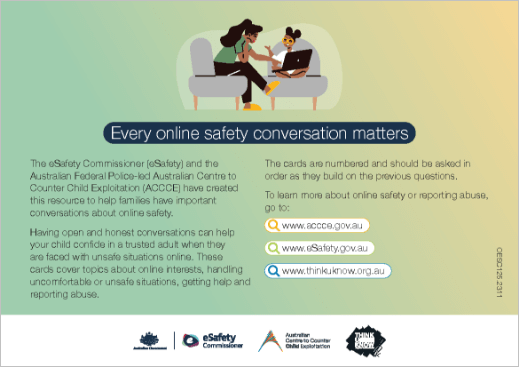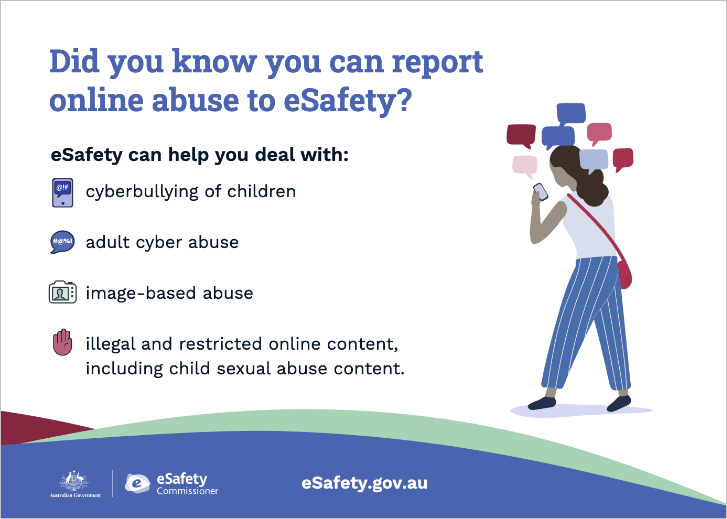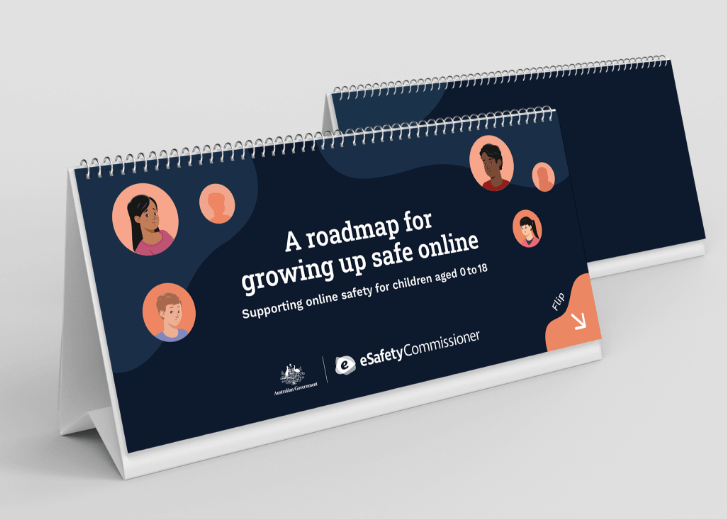How you can protect children from online harm
Community organisations, services and practices can play a key role in protecting children and young people from online risks by building safety into their own operations and activities.
On this page:
Social media changes are coming
As of 10 December 2025, many social media platforms are not allowed to let Australians under 16 have an account.
What you need to know:
- As of 10 December 2025, Facebook, Instagram, Kick, Reddit, Snapchat, Threads, TikTok, Twitch, X and YouTube are required to take reasonable steps to prevent Australians under 16 from having accounts on their platforms. See the latest list.
- Under-16s are still allowed to see publicly available social media content that doesn’t require logging into an account.
- Most standalone gaming and messaging apps, as well as many services that support health and education, are not affected by the new law.
- There are no penalties for under-16s who access an account on an age-restricted social media platform, or for their parents or carers. This is about making the platforms take greater responsibility for the safety of children – they face penalties of up to $49.5 million if they don’t take reasonable steps to implement the changes.
For more, visit eSafety’s frequently asked questions.
Join a free information webinar about the new laws.
Share these resources with parents or use them in your organisation, service or practice to talk about the changes and answer children and young people's questions about online safety.
Explore eSafety resources for young people
- FAQs for young people – answers to common questions
- Get-ready guide for under 16s, with a personal action plan to fill out
- I need help – something has happened online
Stay up to date
Sign up for events, resources and the latest advice to help you support families and communities stay safe online.
Know the risks
If you work in an organisation, service or practice that’s in contact with children and families, you can make a difference to their online safety.
The first step is to understand how online abuse happens. This will help you recognise potential risks in your own operations and take steps to protect children and young people from them. The most serious risks are:
- cyberbullying – being mean and hurtful to a child online
- sharing, or threatening to share, nude or sexual images or videos of a child (known as ‘image-based abuse’) – this includes ‘revenge porn’ and ‘sextortion’
- child sexual abuse – including pressuring someone under 18 to share sexual images or videos or to get sexual in an online chat or video call
- domestic and family violence – including coercive control and stalking targeting a child or a person they are with.
To learn more about how these abuses can happen, go to our page about Online risks for children in your community.
Know how to help someone report online abuse
Knowing how to recognise online abuse and what to do if a child experiences it means you’re ready to take action. You can stop abusive behaviour, limit the spread of harmful content and help the child or young person recover faster.
eSafety research shows children and young people who have experienced abuse want adults to:
- listen without shaming them, especially about their tech use
- focus on their experience and what they are feeling
- be there for them and believe them
- help them get harmful content removed from the internet
- help them get more support from the police, legal and counselling services.
To find out common signs of abuse, as well as the various pathways for reporting it and getting support from eSafety, the police and counselling services, go to our page about how to help a child experiencing online abuse.
Include online risks in policies and procedures
Ensure the policies and procedures of your organisation, service or practice cover online safety.
These should:
- assess online safety risks and define strategies for addressing them
- set expectations that encourage respectful behaviour online – by leaders, staff, volunteers and community members, including children and young people and their families
- include procedures for reporting online abuse, including when the child’s parent or carer should be notified
- uphold the digital rights of children and the National Principles for Child Safe Organisations, including balancing the right to safety, freedom and protection online
- be referred to by staff and volunteers when determining safe use of digital technologies around children and young people
- be displayed publicly where possible and referred to when working with children and young people – you can use the eSafety commitment poster.
If you are working in a foster, kinship or residential service, the Safe and Connected: Supporting online safety for children and young people in care report developed by the Centre for Excellence in Therapeutic Care provides valuable advice on meeting the online safety needs of children and young people.
Reflect and plan for a safer community
You can use eSafety’s Reflection and planning tool to assess risks, decide a holistic approach, and train staff and volunteers in online safety. It includes a quiz, downloadable PDF modules and an example of good practice that will help you identify and prioritise opportunities for improving online safety in your community.
Modules
- Protect children from online harm
- Support families to keep children safe online
- Lead online safety initiatives in your organisation
Talk about child sexual abuse
eSafety, police and researchers see reports of online sexual abuse increasing each year – and we know not all abuse is reported. It’s especially important for community organisations, services and practices to understand how child sexual abuse happens online, address it in their policies, and take practical steps to prevent it in their own operations and activities. Find out more about child sexual abuse online.
You should also be familiar with the laws that govern online activities, including laws that make it illegal to groom children for the purpose of sexual abuse or to create sexual abuse and exploitation material. Learn more about the laws in each state via Youth Law Australia.
You can download the '6 things you can do to help prevent child sexual abuse online' poster to display in staffrooms to highlight practical ways that leaders, staff and volunteers can prevent child sexual abuse in their organisation, service or practice.
Make your commitment public
Let people in your community know about your policies and procedures for online safety, and what you expect of your own leaders, staff and volunteers.
Talking with families in your community can also help you understand their experiences and concerns, to help you identify the best safeguarding strategies to prevent abuse.
It’s especially important to show children, young people and families how they can report any online abuse that happens in your organisation, service or practice.
This includes helping children and young people understand what they should do if they feel unsafe or uncomfortable online or while using digital technologies such as devices and apps. For some organisations it can be helpful to identify a key person who can help with online safety issues. You can also encourage families to talk with young people about identifying trusted adults at home and school and in other parts of their community.
Display the poster and badge
eSafety’s interactive commitment poster is based on our Youth Aspirational Statement and what children and young people want from adults to help them stay safe. It allows you to enter details of how your organisation will keep children and young people safe online as well as adding your organisation’s logo. Click the link to download, edit and print it.
eSafety also has free badges to let children know that staff are open to talking about online safety issues. You can order or download the resources from us.
Start a conversation
You can start a conversation about online safety with children and young people by discussing how you expect them to behave online and how they feel about their online experiences.
Here are some examples.
- How do you use digital devices?
- What safety strategies do you use when you’re online?
- How do digital devices make your life easier, or help you feel connected?
- What online apps or communities help you feel safe?
- Who do you connect with and trust online?
- What does it feel like when you're online?
- Are there any spaces online that feel unsafe, confusing or scary?
- Who are the people that you feel you can talk to if anything goes wrong online?
For ideas about starting a wider conversation in your community, go to How to help families keep children safer online.
Use digital technologies safely
Lots of different devices, apps, platforms and services have functions that help us connect with others and manage our lives, environment and experiences. Community organisations, services and practices that use technology to connect with children, young people and families need to follow safety procedures to reduce the risks.
Click or tap on the + signs to find out more.
Manage photo and video sharing
Taking photos and videos can be an important way to build connection between children, young people, families and the community around them. However, they can expose children to risks if photos and videos are used to share personal information or abuse children. Children and young people are safer when the adults around them consider their needs and rights, and ask before taking and sharing photos and videos of them. In some contexts, it might be safest not to take photos or videos of children.
Strategies for taking photos or videos of children safely
- Teach children about asking for consent for taking or sharing photos and videos.
- Ensure appropriate permissions have been granted, including from the child or young person and their parent/carer or guardian. Check these permissions (including written permission) before taking or sharing photos or videos of children.
- When getting written permission to take or share photos of children, be clear about storing and sharing photos and videos of children and young people with them and their parent/carer or guardian, including details of where, how and for how long images are stored.
- Make a habit of checking whether the child is comfortable by using their preferred communication style and asking for consent/permission immediately before taking photos and videos and before posting online. Consider the developmental maturity and ability of the child to understand what they are consenting to and what that means.
- Even where you have the consent of the child or young person, ensure you check the photo is appropriate to share with a wider audience. This might be an issue when sharing photos of children in swimming or gymnastics gear, or in vulnerable settings such as healthcare or childcare settings. If you’re not sure, don’t share the material.
- Take photos and videos in public spaces, or with another responsible adult present, unless a specific organisational policy provides direction for taking them privately. Never take photos or videos of children without clothes on, even when changing nappies or providing medical care.
- Where images or videos of children are shared on social media sites or platforms, consider turning off comments and sharing of posts to avoid bullying, harassment or abuse of the children.
- Consider circumstances that could place a child at risk of harm if their image or information is shared, such as where there may be legal proceedings or a court order relating to child protection, custody, domestic violence or family separation.
- Remind children, young people and families about how to report inappropriate behaviour or abuse, or request removal of content.
Manage online chat and video calling
Online chat and video calling have become everyday tools for contacting people we know as well as making new connections. While it’s safer for adults to avoid online chat and video calls with children, sometimes it can be necessary as part of your community life, service or practice. It’s important to understand how to communicate appropriately with children and young people.
Strategies for using online chat and video calling with children and young people
- Always ensure you have at least one other person in any online communication with a child or young person, such as their parent, carer or another nominated adult. This is sometimes referred to as ‘two-deep’ communication.
- Avoid communicating with children, young people, parents or carers via your personal email address, phone number or social media accounts.
- Avoid using personal devices to send private messages to children or young people, except where there’s an approved organisational policy governing the arrangement.
- Avoid talking about personal subjects or engaging in overly familiar online chat. In community contexts ensure that digital communications always prioritise the safety and wellbeing of the child or young person.
- Never share sexualised content with children or young people, especially if you’re in a position of power over them. This may include when you provide health, education or youth services to a child or young person.
- Remind children, young people and families about how to report inappropriate behaviour or abuse, or request removal of content.
Manage live streaming
Live streaming allows you to broadcast presentations and events to other people. However, live streaming – particularly if a child or young person is sharing what they’re doing with an unknown audience – can be a high-risk activity because it’s difficult to control live behaviour and manage who’s recording the stream.
Strategies for live streaming involving children and young people
- Live streaming is not available for children and young people on many apps. For example, on TikTok you’re not allowed to live stream until you are 18 years old.
- Never encourage a child or young person to live steam their own activities or events.
- Where your organisation, service or practice is live streaming an activity or event that includes a child or young person, make sure their location isn’t easily recognisable, personal information about them can’t be found through the details of the account used for the live streaming, and comments are turned off or carefully moderated.
- Where a child or young person is live streaming an activity or event because of a commercial arrangement or special circumstance, always ensure they are supervised by someone who’s legally responsible for them and can manage their experience. This may include turning off or moderating comments.
- Remind children, young people and families about how to report inappropriate behaviour or abuse, or request removal of content.
For more tips, go to our pages about online tools and features.
Stay up to date
Join a webinar
Enquire about eSafety’s free tailored presentations and workshops for community organisations, services and practices to build the online safety knowledge and skills of staff and volunteers.
Explore the latest trends and research
Stay up to date with the latest tech trends and emerging issues through eSafety’s regular updates and insights in our position statements and research reports.
Subscribe to eSafety's free newsletter for child and family sector workers
Receive regular updates with the latest information and advice.
Order resources
eSafety has free resources that you can order, as well as download from this page, to help leaders, staff and volunteers understand and implement the latest online safety strategies. You can also display the resources and share them throughout your community.
Find more tips for using the resources on our page about How to help families keep children safe online.
To order the resources, email us at childrenyouthfamilies@esafety.gov.au with the names of the resources you would like to order, quantity, and language required.
The 6 things you can do to help prevent child sexual abuse online staffroom poster is available to order in English, Arabic, Punjabi and Simplified Chinese.
The 4 things you need to know about prevent online abuse poster for families is available to order in English, Arabic, Punjabi and Simplified Chinese.
The We can talk about online child sexual abuse poster for families is available to order in English, Arabic, Punjabi and Simplified Chinese.
The Every online safety conversation matters conversation cards and factsheet for families are available to order in English, Arabic, Punjabi and Simplified Chinese.
The ‘Online safety badge’ is available in English only (use the Commitment poster with the badge).
The ‘How to report abuse postcard’ is available to order in English, Arabic, Burmese, Simplified Chinese, Dari, Hazaraghi, Nepalese, Punjabi, Somali and Swahili.
The ‘A roadmap for growing up safe online’ flipbook for organisations to display and share with families is available in English only.
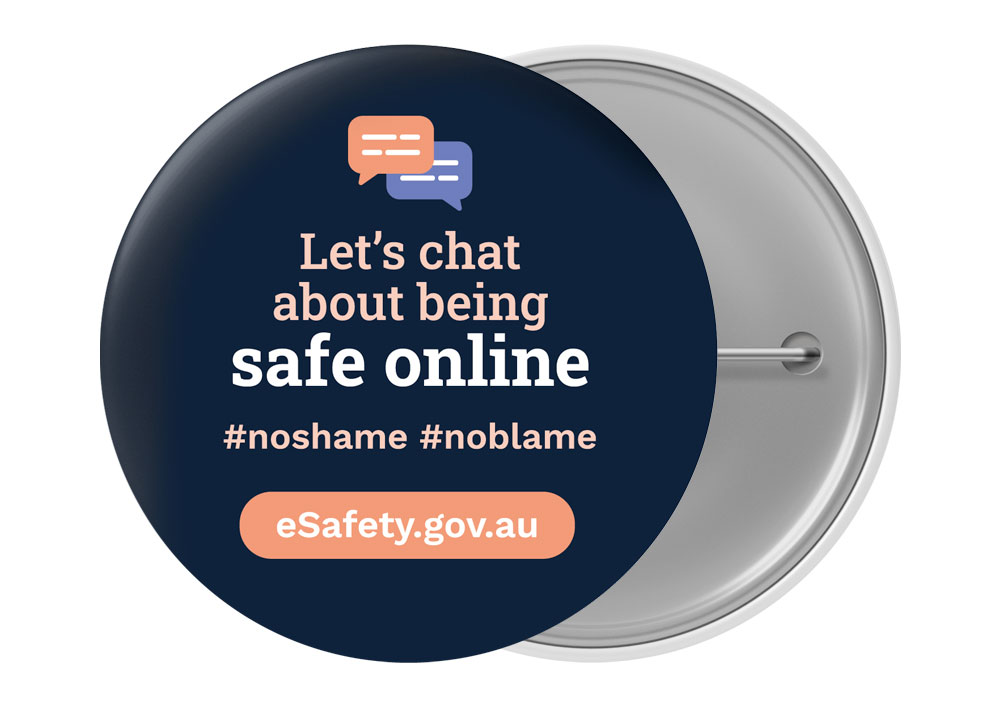
Online safety badge
Last updated: 10/12/2025
